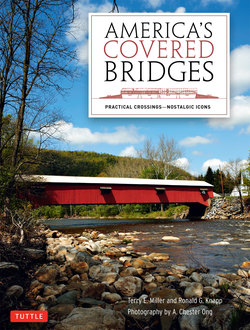Читать книгу America's Covered Bridges - Ronald G. Knapp - Страница 6
На сайте Литреса книга снята с продажи.
ОглавлениеPublished by Tuttle Publishing, an imprint of Periplus Editions (HK) Ltd
www.tuttlepublishing.com
Text copyright © 2013 Terry E. Miller and Ronald G. Knapp Photographs copyright © 2013 A. Chester Ong
All rights reserved. No part of this publication may be reproduced or utilized in any form or by any means, electronic or mechanical, including photocopying, recording, or by any information storage and retrieval system, without prior written permission from the publisher.
ISBN: 978-1-4629-1420-3 (ebook)
Distributed by
North America, Latin America & Europe
Tuttle Publishing
364 Innovation Drive
North Clarendon, VT 05759-9436 USA
Tel: 1 (802) 773-8930
Fax: 1 (802) 773-6993
info@tuttlepublishing.com
www.tuttlepublishing.com
Japan
Tuttle Publishing
Yaekari Building, 3rd Floor
5-4-12 Osaki
Shinagawa-ku
Tokyo 141-0032
Tel: (81) 3 5437-0171
Fax: (81) 3 5437-0755
sales@tuttle.co.jp
www.tuttle.co.jp
Asia Pacific
Berkeley Books Pte Ltd
61 Tai Seng Avenue, #02-12
Singapore 534167
Tel: (65) 6280-1330
Fax: (65) 6280-6290
inquiries@periplus.com.sg
www.periplus.com
15 14 13 10 9 8 7 6 5 4 3 2 1
Printed in Singapore 1311TW
TUTTLE PUBLISHING® is a registered trademark of Tuttle Publishing, a division of Periplus Editions (HK) Ltd.
(Page numbers correspond to the print edition).
Front cover Spanning scenic Loyalsock Creek at Forksville (population 147) in Sullivan County in Pennsylvania’s northeast, the Forksville Bridge is one of the state’s most attractive covered bridges. Because it carries the relatively heavy traffic of Bridge Street going to and from SR 154, the state has hidden I-beams beneath the deck for safety and forestall replacement on the grounds of its official “inadequate” rating. The bridge was designed and constructed in the 1850s by Sadler Rogers, who created bridges large and small in the area. When yet a young man, he built a scale model of the rugged Burr truss that supports this 153-foot span. Although most of present-day Sullivan County (population under 7,000) is heavily forested, during the nineteenth century the hills and mountains were denuded by lumbermen, and vast quantities of hemlock logs were sent by raft down Loyalsock Creek under this bridge to the local tanneries. (A. Chester Ong, 2012)
Back cover One of ten remaining covered bridges in California, the Bridgeport Bridge dates to 1862 (page 244). With the demise of New York’s Blenheim Bridge in 2011, this striking single-span Howe truss bridge with a clear span of 210 feet now has the greatest span of any bridge in the United States.
Front flap Hillsgrove, a hamlet nestled in Sullivan County, Pennsylvania’s Appalachian uplands, illustrates well the ephemeral character of timber bridges: the need for bridges to carry pedestrians, carriages, and railways; technological change and the replacement of materials; and the role of covered bridges in the “industrialization” of once heavily wooded areas. Constructed by Sadler Rogers in the 1850s, the wooden bridge on the left led directly into the settlement, while the taller railroad bridge brought timber-laden railcars to the odoriferous and polluting tannery, an industry that began in 1870 and lasted in Hillsgrove until 1924. As engines became larger, rail traffic increased, the industry flourished, and the wooden covered railway bridge was replaced by a “modern” iron truss bridge. Because tannin extracted from the bark of the bountiful hemlock trees in the area was used to produce leather from hides, a boom in population benefited this area. By 1890, 805 people inhabited Hillsgrove, but with the man-made development of acetone to replace tannin there was the following decline: 1900, 686; 1920, 273, and by 1930, 50 persons left. At the beginning of the twenty-first century, with a year-round population of about 70, the hamlet and surrounding area entice countless visitors to enjoy its reforested hillslopes, clean water, and fresh air. Branded as Pennsylvania’s Endless Mountains, locals take great pride in the three surviving covered bridges at Forksville, Hillsgrove, and Sonestown even as others are only recalled in memory and faded photographs. (Sullivan County Historical Society’s Museum)
Spine The Schofield Ford or Twining Ford Bridge, which was originally completed in early 1874 in Bucks County, Pennsylvania (page 205), was burned by arsonists in 1991 and completely rebuilt in 1997 by local volunteers. Today, it offers passage across the picturesque Neshaminy Creek in Tyler State Park. A stone pier supports the bridge, which likely was constructed as a single span utilizing the Town lattice truss. (A. Chester Ong, 2010)
Page 1 Blacksmith Shop Bridge, New Hampshire (page 171). (A. Chester Ong, 2010)
Page 2 Knight’s Ferry Bridge, California (page 248). (A. Chester Ong, 2012)
Page 5 Twining Ford Bridge, Pennsylvania (page 205). (A. Chester Ong, 2010)
Pages 6–7 Ashuelot or Upper Village Bridge, New Hampshire (page 166). (A. Chester Ong, 2010)
Front endpaper The longest historical covered bridge in the United States, the Cornish-Windsor Bridge (page 172), crosses the Connecticut River between New Hampshire and Vermont. On a heavily traveled route with a ten-ton load limit, the bridge carries two-way traffic day and night. In addition to ongoing maintenance to its Town lattice truss, extensive repairs have been carried out periodically since it was constructed in 1866. (A. Chester Ong, 2010)
Back endpaper Thomas Wilson’s painting of Eagle Mills in Rennsselaer County, New York, depicting the village around 1845, places a two-lane covered bridge at its center, flanked by large mill- or factory-type structures along with a wooden mill building next to the dam. Today, a cider mill sits next to the dam and an undersized covered two-lane pedestrian bridge crosses Poesten Kill nearby. The main part of the village is seen in the distance. (Colonial Williamsburg Foundation, Abby Aldrich Rockefeller Folk Art Museum)
